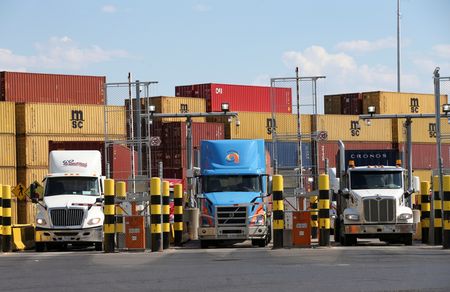By Julie Gordon
OTTAWA (Reuters) -Canada’s economy grew slightly more than expected in August and most likely stayed in positive territory through the summer, official data showed on Friday, a result that did not change expectations for another smaller rate hike.
The economy grew by a surprise 0.1% in August, buoyed by strong agricultural and retail activity, with another 0.1% increase likely in September and third quarter annualized GPD seen up 1.6%, Statistics Canada data showed.
Analysts polled by Reuters had forecast GDP would be flat in August. The flash estimate for annualized GDP, which may change when final tallies are released next month, is slightly above the Bank of Canada’s third quarter forecast of 1.5% growth.
“The Canadian economy has been only crawling ahead recently,” Royce Mendes, head of macro strategy at Desjardins Group, said in a note.
“The numbers shouldn’t change anything for monetary policymakers, who sounded more dovish than anticipated on Wednesday,” he added.
The Bank of Canada increased its policy rate this week by 50 basis points to 3.75% and said it was nearing the peak of its tightening campaign, though it was not there yet. Money markets are betting on a 25-basis-point increase at its December decision.
Inflation has eased off its peak, but remains far above the central bank’s 2% target. The bank warned that growth would stall in the fourth quarter, with its forecasts showing a slight recession was possible in the coming months.
“While growth was fairly modest in Q3, it will probably need to slow further to help bring inflation back to target,” Andrew Grantham, senior economist at CIBC Capital Markets, said in a note.
The August GDP data showed a rebound in services partially offset a decline in goods-producing industries. Retail trade rose 1.2%, bouncing back from July, on higher sales at the gas pump, at grocery stores and in sporting goods shops.
The agriculture and forestry sector rose 3.9%, led by increased crop production as better growing conditions in Western Canada drove higher yields.
That was offset by a contraction in manufacturing, with sector output falling to its lowest level since January. Construction also declined for a fifth straight month, though building activity remains well above pre-pandemic levels.
The Canadian dollar was trading 0.3% lower at 1.3610 to the greenback, or 73.48 U.S. cents.
(Reporting by Julie Gordon in Ottawa, additional reporting by Dale Smith, Fergal Smith, Angus MacSwan and Andrew Heavens)

